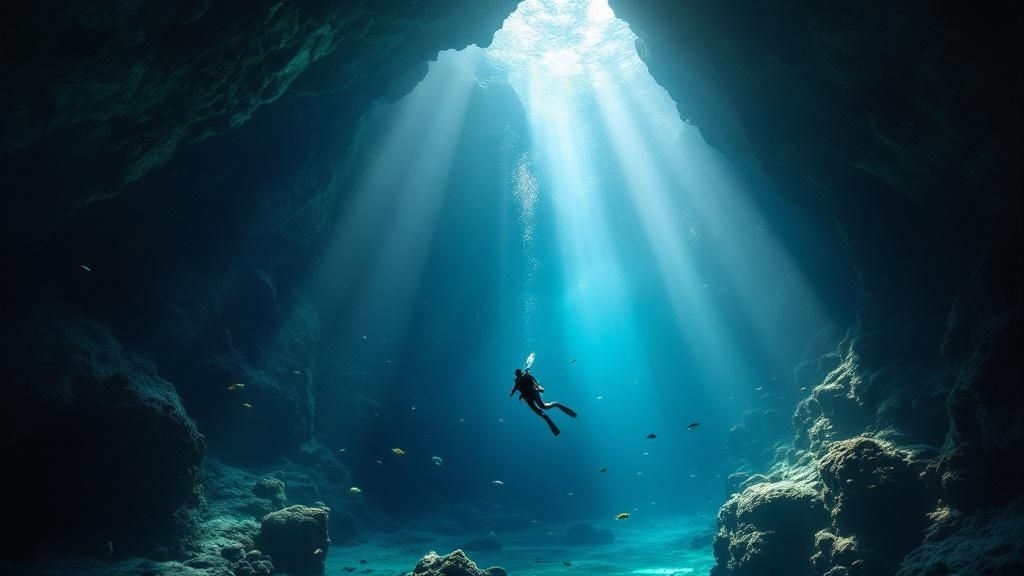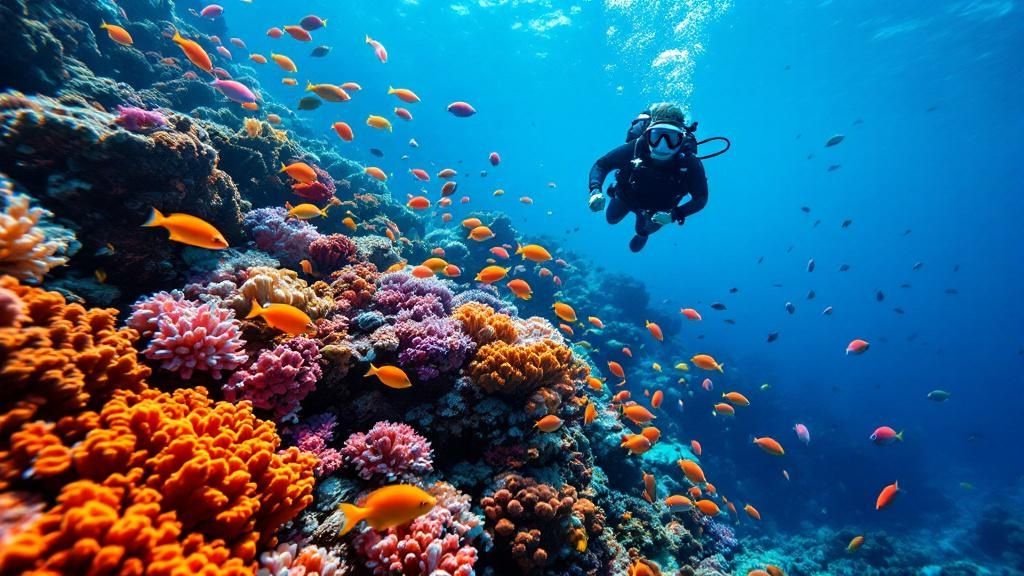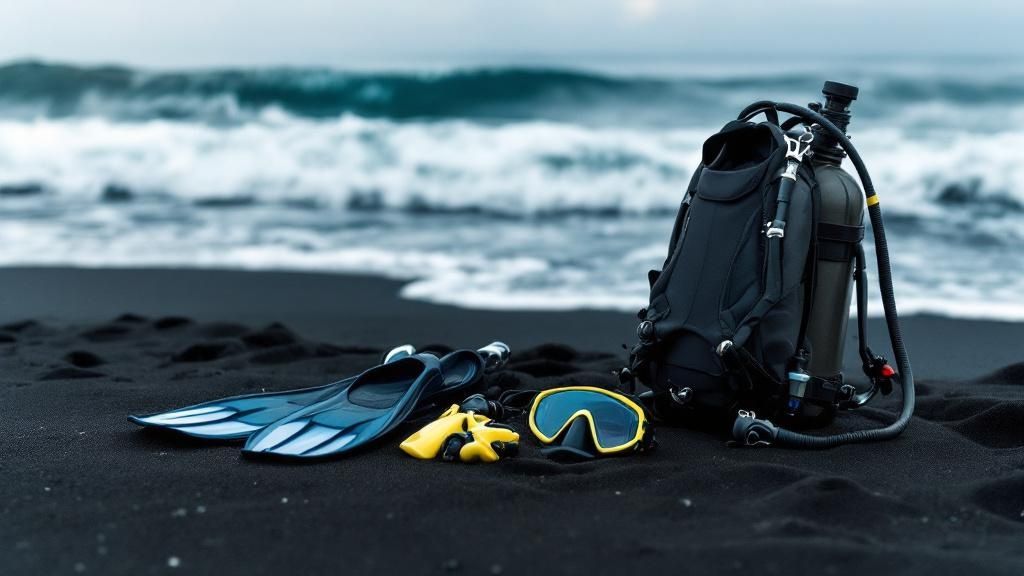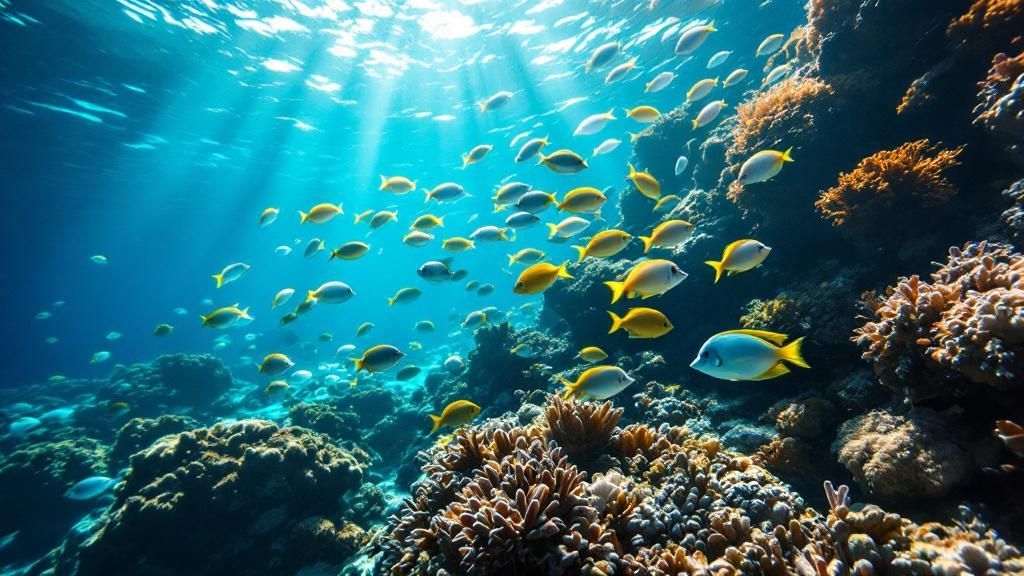Imagine dropping into impossibly clear, turquoise water, gliding through ancient lava tubes, and coming face-to-face with majestic green sea turtles. This isn't just a daydream; it's the everyday reality of Big Island scuba diving.
This guide is for everyone, whether you're taking your first breath underwater or you're a seasoned pro looking for that next big thrill, like the world-famous manta ray night dive. We'll pull back the curtain on why the Kona coast is a global diving hotspot, what you'll see beneath the waves, and how to pick the perfect dive operator for your adventure.
Why the Big Island Offers World-Class Scuba Diving
For divers around the world, scuba diving Big Island Hawaii is a bucket-list experience. But what makes it so special goes much deeper than just pretty reefs. The secret lies in the island's volcanic soul. The Kona coast's underwater world was forged by fire, creating a dramatic playground of lava tubes, massive archways, and intricate caverns that you won't find anywhere else.
This unique geology is the foundation for Kona's incredible diving. These structures act as natural apartment complexes for a stunning density of marine life. On top of that, the colossal volcanoes of Mauna Loa and Hualalai serve as a giant shield, protecting the western coast from the powerful trade winds.
The result? The water here is almost always calm and incredibly clear, with visibility that often pushes past 100 feet. It's this perfect storm of bizarre, beautiful underwater landscapes and ideal conditions that puts scuba Big Island on the map. You can get even more details in our comprehensive guide to Big Island Scuba Diving.
To get a quick sense of what makes diving here so special, here's a snapshot of the key highlights.
Big Island Diving At a Glance
| Feature | Description | Best For |
|---|---|---|
| Volcanic Topography | Explore underwater lava tubes, arches, and craters formed by ancient lava flows. | Adventurous divers, underwater photographers |
| Exceptional Clarity | Visibility often exceeds 100 feet thanks to the sheltered Kona coast. | All divers, especially those new to scuba |
| Calm Conditions | The island's volcanoes block trade winds, creating placid water year-round. | Divers of all skill levels, from beginner to pro |
| Rich Marine Life | Home to endemic species, sea turtles, dolphins, and world-famous manta rays. | Wildlife enthusiasts, night divers |
| Signature Dives | Iconic experiences like the Manta Ray Night Dive and Pelagic Blackwater Dive are unique to the Big Island. | Thrill-seekers, experienced divers |
From the legendary Manta Ray Night Dive to drifting over pristine coral gardens, the Big Island truly has an underwater adventure for every type of diver.
Exploring Kona: The Epicenter of Hawaii Diving

When you hear divers talk about the Big Island, they're almost always talking about Kona. The Kona coast isn't just another spot on the map; it’s the heart and soul of the Big Island diving scene. Tucked away on the island's western side, it’s shielded by the immense volcanic masses of Mauna Loa and Hualalai.
Think of these volcanoes as giant bodyguards. They stand tall against the powerful trade winds that can churn up the waters elsewhere in Hawaii, creating a diver's paradise on the leeward coast. This unique geography is the secret sauce behind Kona's legendary conditions: consistently calm, comfortably warm, and unbelievably clear.
But the magic of Kona diving goes deeper. The very thing that created the islands—lava—has also sculpted a breathtaking underwater world. Ancient lava flows have frozen in time, forming a dramatic playground of arches, deep caverns, and thrilling swim-throughs. It feels less like a standard reef and more like exploring a submerged volcanic wonderland.
Why Kona's Conditions Are a Diver's Dream
One of the first things you'll notice is the visibility. It's not uncommon for it to exceed 100 feet, making you feel like you're flying through a massive, sunlit aquarium. This incredible clarity turns every dive, from shallow explorations to deeper adventures, into a true visual feast.
The perfect storm of conditions that makes diving Hawaii Big Island so special is all concentrated right here:
- A Geological Shield: Those massive volcanoes create a natural barrier, which means calm, predictable waters perfect for divers of all stripes.
- Volcanic Playgrounds: The seafloor is a stunning maze of lava tubes and canyons, offering endless nooks and crannies to explore.
- Thriving Ecosystems: These unique structures are the perfect foundation for a dense and vibrant marine ecosystem, packed with everything from tiny critters to big pelagic visitors.
This blend of accessibility and high-adventure is what makes diving Big Island an absolute must for any certified diver.
A true crown jewel of the Kona coast is the Kealakekua Bay Marine Life Conservation District. As one of Hawaii's absolute premier destinations for scuba diving Big Island Hawaii, the bay is famous for its stellar visibility. Because it’s a protected sanctuary where fishing is prohibited, the whole ecosystem is supercharged. You'll find huge schools of tropical fish like yellow tangs and parrotfish swarming over a reef of vibrant hard and soft corals. You can dive deeper into the underwater world of the Big Island to get a taste of what awaits.
Choosing Your Kona Adventure
With so many world-class sites clustered together, Kona diving companies like Kona Honu Divers can put together the perfect day for any interest. Whether your dream dive involves drifting along a coral-encrusted wall or navigating an ancient lava tube, there's a site here for you.
The real beauty of Kona is that it delivers elite diving conditions without requiring elite-level difficulty. Beginners can feel safe and confident, while advanced divers can find challenges that push their skills. It's a truly democratic diving destination.
Ready to see for yourself why Kona is the undisputed king of scuba Big Island? Those calm, clear waters are waiting.
The World-Famous Kona Manta Ray Night Dive

Imagine this: you’re kneeling on the dark ocean floor, your dive light pointing a single beam up into the water. Then, out of the blackness, a graceful giant with a wingspan of over 12 feet materializes, performing a silent, acrobatic ballet just inches above your head. This isn't a scene from a movie—it's the legendary Manta Ray Night Dive, the absolute crown jewel of Big Island diving.
This is one of those true bucket-list experiences, an encounter with wildlife so unique it's hard to compare to anything else. The setup is often described as an "underwater campfire." Dive operators place powerful, eco-friendly lights on the seafloor, which attract clouds of microscopic plankton. This floating buffet, in turn, draws in the majestic resident manta rays for a spectacular feeding frenzy.
For anyone who takes the plunge on this iconic Kona diving adventure, the feeling is hard to put into words. You're a silent observer as these gentle giants glide, swoop, and barrel roll through the light beams, filtering plankton from the water. It’s a profoundly moving experience that forges an unforgettable connection with one of the ocean's most magnificent creatures.
How This Iconic Dive Began
This world-renowned dive didn't just pop up overnight. As one of the most famous scuba diving Big Island Hawaii experiences, it actually has humble beginnings tied to local tourism. The whole thing kicked off in the early 1980s when a few pioneers noticed that manta rays were drawn to the lights from a hotel shining on the water.
It didn't take long for operators to realize they could recreate this phenomenon offshore, creating a consistent and absolutely magical encounter for divers. That happy accident evolved into the highly organized, sustainable tour that has made diving Hawaii Big Island synonymous with manta rays, attracting divers from all over the world.
A Sustainable and Safe Encounter
The incredible, long-term success of this scuba Big Island attraction comes down to a community-wide commitment to protecting the rays. Reputable Kona diving companies are all-in on sustainable practices that put the health and safety of the local manta population first.
- Passive Observation: Before you even get in the water, you're briefed to stay on the bottom and never, ever touch, chase, or get in the way of the mantas. You're a guest in their dining room.
- Smart Light Placement: The lights are set up to draw in plankton without disorienting the animals, creating a safe "stage" for their feeding ballet.
- Manta Advocacy: Many operators, including us here at Kona Honu Divers, actively contribute to manta ray research and conservation. The goal is to better understand these amazing animals so we can protect them for generations to come.
This carefully structured approach guarantees an experience that is just as safe for the mantas as it is breathtaking for the divers. You can get a full rundown of the guidelines and what to expect on our comprehensive Manta Ray Night Dive page.
This isn't just another dive to tick off a diving Big Island checklist. It's a front-row seat to one of nature's greatest performances, leaving everyone who witnesses it with a renewed sense of wonder for the ocean's mysteries.
Must-Visit Dive Sites for Every Skill Level

Sure, the manta ray night dive might get all the fame, but what truly makes Big Island scuba diving a world-class adventure is the incredible variety of sites packed along the coast. The Kona coast is basically a treasure map of underwater gems, with a perfect spot for everyone—from divers taking their first breath underwater to salty pros hunting for their next big thrill.
The underwater landscape here, carved by thousands of years of volcanic flow, means no two dives are ever alike. It’s this diversity that guarantees you’ll find an adventure that fits you perfectly, no matter your experience. For those new to Kona diving, there are calm, protected coves that serve as a beautiful and safe introduction. Meanwhile, advanced divers can explore dramatic underwater architecture and come face-to-face with unique pelagic creatures you just won't find anywhere else.
Building your dream diving Hawaii Big Island itinerary all starts with knowing where to point the boat. Let's dive into some of the must-see spots that really show off what scuba diving Big Island Hawaii is all about.
Beginner-Friendly Havens
When you're a new diver, it's all about building confidence. The best beginner sites have calm water, shallow depths, and enough colorful fish to make you feel like you’ve dropped into an aquarium. One of the most loved spots is Two Step (Honaunau Bay), famous for its ridiculously easy entry and crystal-clear conditions.
Here's what makes it so great:
- Shallow Reefs: The main reef sits in just 20-30 feet of water. That means you get long, relaxed bottom times without ever worrying about going too deep.
- Fish Everywhere: The whole area is a vibrant nursery for reef fish. You'll see clouds of yellow tangs, butterflyfish, and parrotfish munching on the coral.
- Guaranteed Turtle Time: Green sea turtles (Honu) are practically a guaranteed sighting. You'll often find them snoozing on the reef or gliding past you with incredible grace.
These sites are perfect for finishing your certification dives or for anyone who just wants to kick back and enjoy the view. If you want more DIY options, our guide to the best shore diving sites in Kona has some fantastic spots for getting more comfortable in the water.
Intermediate and Advanced Playgrounds
Once you’ve got your buoyancy dialed in, the world of diving Big Island opens up to reveal some truly dramatic scenery. These sites demand a bit more skill but reward you with unforgettable experiences. A prime example is Au Au Crater, a massive, submerged volcanic cone. The dive's highlight is a breathtaking swim-through that takes you right into the crater's center, where beams of sunlight stream down from above.
Another awesome spot is Crescent Beach, known for its stunning lava archways and swim-throughs. Navigating these formations feels like you're exploring ancient, underwater cathedrals. These sites usually have slightly deeper profiles, from 40 to 80 feet, and are magnets for larger marine life like schooling jacks and the occasional white-tip reef shark cruising the perimeter.
The real magic of scuba diving Big Island is how the volcanic landscape creates a three-dimensional experience. You're not just swimming over a reef; you're swimming through it, under arches, and into collapsed lava tubes.
To give you a better idea of what to expect and where, here's a quick comparison of some of the most popular dive sites around the island.
| Dive Site | Skill Level | Max Depth | Key Feature |
|---|---|---|---|
| Two Step (Honaunau Bay) | Beginner | 30 ft | Easy shore entry, calm water, abundant turtles. |
| Manta Heaven | All Levels | 40 ft | World-famous manta ray night dive location. |
| Au Au Crater | Intermediate | 60 ft | Submerged crater with a huge swim-through. |
| Crescent Beach | Intermediate | 80 ft | Lava rock archways and swim-throughs. |
| Black Water Dive | Advanced | Tethered Drift | Pelagic drift dive to see deep-water creatures. |
This is just a small sample, of course. Each site offers a completely different vibe and a new set of creatures to meet, which is what keeps us coming back for more.
The Ultimate Adventure: The Black Water Dive
For the truly adventurous diver—the one looking for a story no one else has—there’s the Black Water Dive. This is not your standard reef tour. This is a pelagic drift dive, done in the dead of night, miles from shore, suspended over thousands of feet of inky black water.
Tethered to the boat for safety, you descend into the abyss and witness one of the planet's largest migrations. Every single night, the weird and wonderful creatures of the deep rise toward the surface to feed. You’ll see bioluminescent jellies that glow in the dark, bizarre larval fish, and squids that look like they’re straight out of a sci-fi movie. Divers often say it feels less like scuba Big Island and more like floating through outer space.
This is a highly specialized dive offered by a select few Kona diving companies, and it's an absolute must-do for any experienced diver looking for a thrill they’ll never forget.
How to Plan Your Big Island Diving Adventure

A truly great dive trip starts long before your fins ever touch the water. Planning your Big Island diving adventure is honestly part of the fun, and a little bit of prep can easily turn a good vacation into a spectacular one. Every choice, from picking the right time of year to finding the best Kona diving companies, will shape the memories you take home.
Think of this as your practical guide to getting it right. We'll walk through everything from seasonal conditions and gear decisions to the unwritten rules of diving with Aloha, making sure your trip is smooth, safe, and respectful to Hawaii’s incredible marine world.
Choosing the Best Time for Your Dive Trip
The best part about Kona diving is that it’s fantastic all year. Seriously. But there are some subtle differences between the seasons that might help you decide when to book your flight.
- Summer (April – October): This is peak season for good reason. You’ll be greeted by the warmest water, often a perfect 80°F (27°C). The ocean is usually at its most calm and visibility is consistently amazing, which makes it the perfect time for any diver, but especially for those getting their first taste of scuba Big Island.
- Winter (November – March): Don't sleep on the winter months! The water might be a touch cooler at around 75°F (24°C), but the diving is still world-class. The real magic of a winter trip? Humpback whales. Hearing their hauntingly beautiful songs reverberate through the water during a dive is an experience that will stay with you forever.
Selecting the Right Kona Diving Company
This is single-handedly the most important decision you'll make for your trip. You're not just booking a spot on a boat; you're picking a partner for your adventure. Look for an operator that lives and breathes safety, sustainability, and giving you an unforgettable experience.
When you choose a dive operator, you're not just renting a spot on a boat; you're entrusting them with your safety and becoming a partner in protecting the reef. Choose a company that takes both responsibilities seriously.
Here’s what to look for when you compare Kona diving companies:
- Safety Record & PADI Certification: First and foremost, make sure they are a certified PADI dive center with a squeaky-clean safety record.
- Boat Amenities: Little things make a big difference. A comfortable, custom-built dive boat with an on-board restroom and fresh water for rinsing off is a game-changer.
- Eco-Conscious Practices: Do they actively help protect the ocean? Choosing responsible operators is essential for the future of diving Hawaii Big Island.
- Experienced Crew: Guides who are genuinely passionate about the ocean and its creatures will transform your dive from a simple swim into a full-blown educational adventure.
Gear Up: Bring or Rent?
The old "bring or rent" debate comes down to personal preference. If you've invested in your own well-maintained gear that fits you perfectly, bringing it is usually a great call. On the flip side, renting from a top-notch shop like Kona Honu Divers means you get high-quality, serviced equipment without the headache of airline fees and extra luggage.
Either way, don't leave home without these essentials:
- Your certification card and logbook
- Reef-safe sunscreen to protect your skin and the coral
- A reusable water bottle to stay hydrated on the boat
- A light jacket or windbreaker for those breezy boat rides
Underwater exploration around Hawaii has a rich history. As far back as 1984, submersibles were exploring depths of 366 meters off these shores. A massive milestone was hit in 2001 with the first dive below 1,000 meters, completely changing our understanding of the deep. If you're a history buff, you can explore the records of Pacific underwater explorations to see just how far we've come.
Dive with Aloha
Finally, the most crucial piece of planning has nothing to do with logistics and everything to do with your mindset. Diving in Hawaii is a privilege, and with that comes the kuleana (responsibility) to be a gracious guest in this delicate underwater realm.
Listen carefully to your divemaster's briefings, keep your buoyancy in check to avoid any contact with the coral, and never, ever chase or harass the marine life. When you embody the spirit of Aloha, you're doing your part to ensure the magic of scuba diving Big Island Hawaii is here for generations to come. For more on this, check out our article on why you should think of diving on the Big Island.
Frequently Asked Questions About Big Island Diving

Planning a dive trip always brings up questions, and for a world-class spot like the Big Island, it’s no different. To help you get your plans locked in and feel confident about your adventure, we’ve put together answers to the questions we hear most often about Big Island scuba diving.
Is there good diving on the Big Island?
Absolutely. The Big Island, especially the Kona coast, has some of the most reliable and incredible diving in all of Hawaii. The underwater world is a wild tapestry of volcanic lava tubes, arches, and craters. Because it's sheltered from the trade winds, the water is almost always calm with visibility often hitting 100+ feet, and it’s packed with marine life, including those world-famous manta rays.
What are the best months to scuba dive in Hawaii?
You can have an amazing dive pretty much any day of the year here, but the prime time is during the summer from April to October. That’s when you’ll get the calmest seas and warmest water, around 80°F (27°C). That said, winter (November to March) is still fantastic in Kona, and you get the added bonus of possibly hearing humpback whale songs on your dive. It's magical.
Is Kona good for scuba diving?
Kona is exceptional for scuba diving. Its unique spot on the leeward (sheltered) side of the island means calm, clear conditions that are perfect for every skill level. It's the hub for the Big Island's most famous dives, like the manta ray night dive, which cements its reputation as a top-tier global destination.
Is it better to snorkel or scuba dive in Hawaii?
It really depends on what you're after. Snorkeling is super accessible and perfect for checking out the shallow reefs. But scuba diving is a completely immersive experience. It lets you explore the deeper lava formations and get up close with wildlife you'd never see from the surface. For those bucket-list moments, scuba is the way to go.
Which Hawaiian island is best for scuba diving?
While you can find beauty on every island, the Big Island is widely seen as the crown jewel for divers. Its combo of amazing water clarity, calm seas, unique volcanic topography, and signature dives like the manta ray and blackwater experiences really sets it apart from the rest.
When to dive Kona?
Kona offers great diving all year. For the warmest water (around 80°F) and flattest seas, aim for April through October. If you want a truly unforgettable experience, plan your trip for the winter (November-March) when you can hear the songs of migrating humpback whales echoing through the water on your dives.
